Episodes

Tuesday Dec 04, 2018
Tuesday Dec 04, 2018
This week, the TWT team presents three live interviews from ASHA with Jill Senner & Matt Baud, Meredith Poore Harold of The Informed SLP, and TWT listener Ashley!
Before the interviews, Rachel and Chris talk about all the great things that happened during Rachel's time speaking, connecting, and learning at ASHA 2018!
Next, we hear from Rachel’s interview at ASHA with Jill Senner & Matt Baud! They briefly discuss Jill & Matt’s talk on parent instruction and partner-augmented input with Kathleen Post, including the importance of pre-testing with video, why we need to move to a collaboration model, and things to get the ball rolling with AAC as a school-based SLP. Jill & Matt were kind enough to share the handouts from ASHA at www.talcaac.com!
For the second of Rachel’s interviews from ASHA, we hear from Meredith Poore Harold, owner of The Informed SLP! She talks about how The Informed SLP (theinformedslp.com) takes journal articles relevant to clinical practice and discusses why the article is important to know about and what the findings were. Meredith also teases a post on her site that details how to get a lot of different academic journal articles for free!
Finally, Ashley, an awesome TWT listener, asks Rachel some questions about AAC! These questions include when to incorporate core words on a new AAC user’s device, when “quick fire” phrases are (and are not) a good idea, and when we should introduce more grammatical morphemes as we model and recast!
We want to know what you think! You can connect with us at our Facebook group Talking with Tech, on Twitter, and Instagram (@talkingwithtech)! Also, please subscribe and post a review for us on iTunes- it helps others to find us!
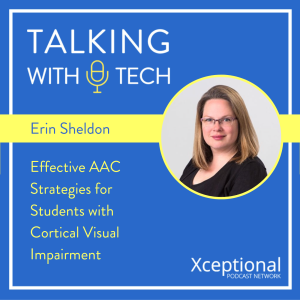
Tuesday Nov 27, 2018
Tuesday Nov 27, 2018
This week, the TWT team interviews Erin Sheldon, literacy and language development specialist for AssistiveWare and school inclusion consultant! Erin shares from her experiences working with visually-impaired AAC users, both professionally and as the parent of a teenager diagnosed with autism and Angelman Syndrome.
Before the interview, Rachel and Chris discuss some of their experiences with visual impairments and AAC, including teaching a student with CVI to communicate with visual & auditory scanning, using high-contrast images on AAC, teaching literacy using braille stickers, and the importance of AAC modeling with visually-impaired students!
Next, Erin shares about her daughter’s CVI, an impairment of the brain’s ability to process visual information. She discusses how they have taught her daughter to use a modified PODD system, and why it has been important that they have always presumed competence. Erin also shares about:
1. Why we “can’t hold a student’s language hostage to their vision” when implementing AAC.
2. Why moving to AAC more quickly can be very beneficial to language development, because children with CVI may understand symbols better than photographs.
3. What partner assisted scanning is, why it is so important for some users, and how it can help build a language foundation faster than when communication is only verbal.
4. What verbal referencing is, and why verbalizing what you understood from a person’s behavior can help improve language development.
5. Why making grids with too few icons OR too many icons can cause students with CVI to plateau.
6. Why we need to look what someone with can access, not just what he or she can see.
7. How to take advantage of colors that are easier to visually identify for some people with CVI, and how mentioning coloring during modeling can help the child connect the color and the icon.
8. How visually-distinct, high-contrast symbols can be effective for students with CVI.
9. Why maintaining the motor plan and icon location is so important for AAC users with CVI.
We want to know what you think! You can connect with us at our Facebook group Talking with Tech, on Twitter, and Instagram (@talkingwithtech)! Also, please subscribe and post a review for us on iTunes- it helps others to find us!
For more links, information, and resources from this episode, visit our podcast page at bit.ly/twtpodcast
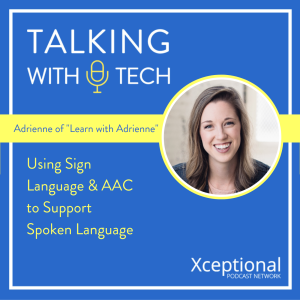
Tuesday Nov 20, 2018
Tuesday Nov 20, 2018
This week, TWT interviews Adrienne of “Learn with Adrienne”, an SLP who specializes in early intervention. Through online videos, she has taught thousands of people how to use sign language to support a child’s language development. She and Rachel discuss several topics, including how sign language and high-tech AAC can be used as part of a multi-modal approach!
Before the interview, Chris and Rachel talk about motivation and why it is such an important part of any intervention. Rachel shares a personal story about a difficult conversation she had with a peer, and why it is important not to be too hard on ourselves when there is a breakdown in communication. Rachel also talks about why we should “inspire not require” our students to communicate, and why placing repeated demands can be so disruptive to progress. Finally, Chris asks why we can't have an AAC course in high school or college - maybe even one that satisfies a language credit!
Next, Rachel interviews Adrienne! They discuss:
1) How Adrienne became interested in early intervention and sign language,
2) How research indicates that learning sign language doesn’t limit spoken language growth,
3) Why teaching sign language can help a child receive more positive feedback,
4) Why it can be helpful to teach students more than one communication modality - e.g., teach both sign language and high-tech AAC devices as needed, and
5) How we should receive an approximation of a sign when a child has their own way signing something!
We want to know what you think! You can connect with us at our Facebook group Talking with Tech, on Twitter, and Instagram (@talkingwithtech)! Also, please subscribe and post a review for us on iTunes- it helps others to find us!

Tuesday Nov 13, 2018
Tuesday Nov 13, 2018
This week, TWT interviews Jenna Rayburn Kirk, the ultra-creative school-based SLP, blogger, and TPT contributor! Jenna shares about how she got started creating resources, the kinds of AAC resources and materials that she thinks are effective, and how she continues to try and create resources that people really need! Before the interview, Chris and Rachel discuss their own experiences with making materials and, in Rachel’s case, why she recently decided to create a Teachers Pay Teachers page. Rachel and Chris also talk about some apps that they have used recently in therapy, including Choice Works and AR Dragon. Finally, Chris discusses “core kits,” a low-tech core vocabulary strategy that could save the day when you need a quick therapy idea.
Next, Rachel interviews Jenna Rayburn Kirk! Jenna talks about how she juggles being a full-time school SLP, AAC specialist, and an entrepreneur; why she is motivated to share her ideas; and how she has gotten to be so popular (over 25,000 followers) on Teachers Pay Teachers! Jenna covers useful topics in AAC and materials creation, including:
1) Why parent handouts are such an effective way to improve AAC implementation at home
2) Why it is helpful to be specific about how to get modeling and working on core vocabulary
3) Why we need to be flexible in how we approach asking for help from the circle of support
4) Why getting buy-in from someone is easier when you show them how you are solving a problem they have.
5) Why it is so important to build strong relationships with teachers, caregivers, and parents
6) Why some students need a “short term” assistive technology plan; not everyone who needs AAC needs it for years.
7) How a school can fill the gap between identification of an AAC need and getting a device funded by having devices available to everyone in the classroom.
8) Why “waiting for words” can delay language too much, because “there is no reason to stunt expressive language while we wait for speech sounds.”
To learn more about Jenna & get access to her TPT store, visit https://thespeechroomnews.com.
For access two free resources from Rachel and the Building Sentences board discussed on the podcast, visit http://bit.ly/RachelMadelTPT
We want to know what you think! You can connect with us at our Facebook group Talking with Tech, on Twitter, and Instagram (@talkingwithtech)! Also, please subscribe and post a review for us on iTunes- it helps others to find us!

Tuesday Nov 06, 2018
Tuesday Nov 06, 2018
This week, TWT interviews Dana Nieder about her journey as an advocate, writer, AAC specialist, speech-language pathologist, and AAC mom! Dana shares about how she always presumed her daughter’s potential, why she shared about her experiences on blogs and social media, and what her many experiences have taught her about AAC! Dana shares many helpful insights, including:
How to deal with members of the circle of support who believe that an AAC user must “prove” they can use a high-tech device before one is provided to them;
Why parents can be such valuable resources and why they are such a key part of any successful intervention;
Why everyone in the circle of support needs to believe an AAC intervention will be successful;
Why we must presume that people with complex communication needs have the potential to succeed;
How to "invest" in an AAC user's circle of support, and why their buy-in and motivation is critical to success;
Why we need to change how we support AAC depending upon both a person's role and his or her comfort level with AAC;
Why we should share AAC modeling videos with people who are unfamiliar with modeling on an AAC device;
Why watching a video of a successful adult AAC user can be so motivating to the circle of support;
and much more!
We want to know what you think! You can connect with us at our Facebook group Talking with Tech, on Twitter, and Instagram (@talkingwithtech)! Also, please subscribe and post a review for us on iTunes- it helps others to find us!
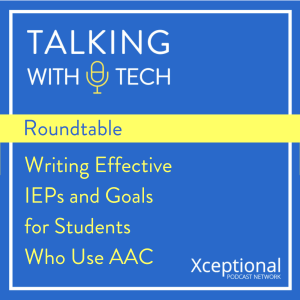
Tuesday Oct 30, 2018
Tuesday Oct 30, 2018
Join the TWT team this week for a roundtable discussion about writing Individualized Education Plan (IEP) goals for students with complex communication needs (CCN). Topics discussed in this roundtable include:
Why augmentative and alternative communication (AAC) devices should be used in early intervention and not just as an ‘intervention of last resort” for students with CCN.
Using the accommodations section to detail what the student needs as part of his or her free appropriate public education.
Adding minutes for coaching the circle of support about AAC on the IEP as a “related service” instead of a “direct service”
Why listing a specific system or app in the IEP can cause problems, and how those problems can be avoided by describing, rather than naming, the system.
Why accessories for AAC devices (keyguard, switches) should be included in the IEP.
Why new training goals may be important when there is a major change in the circle of support.
Why being specific about what you are going to measure in a goal is critical when you are measuring it later.
The need to go beyond requesting when writing goals - include commenting protesting, asking questions, etc.
AAC therapy is language therapy - in many cases you don’t even need to mention the system or app when writing a language goal
Who should be responsible for an AAC-related goal on the IEP?
We want to know what you think! You can connect with us at our Facebook group Talking with Tech, on Twitter, and Instagram (@talkingwithtech)! Also, please subscribe and post a review for us on iTunes- it helps others to find us!

Tuesday Oct 23, 2018
Tuesday Oct 23, 2018
The TWT team is joined this week by Lindsey Paden Cargill, a speech-language pathologist and AAC specialist who works at Bridgeway Academy in Columbus, Ohio! Lindsey is the creator of the Chatterbox Challenge, an event that seeks to improve the modeling and prompting skills of caregivers and teachers of children who use AAC. During this challenge, caregivers and teachers communicate in a social setting using their student’s AAC device and no oral language!
Before the interview, Rachel and Chris share some modeling “tips and tricks” for AAC communication partners that can be used to improve modeling and prompting. Some of these tips include:
Using an AAC app’s search function instead of visual scanning when looking for a vocabulary word,
Modeling for the student at their language level (or one step above),
Coordinating “core word of the week” at home and in the classroom,
Using peers and siblings as modeling “buddies,” and
Using “scripts” describing how to model a particular book to increase AAC modeling during shared reading time.
Following this discussion, Chris connects with Lindsey Paden Cargill to talk about her work with AAC and the Chatterbox Challenge! First, Lindsey shares about how her efforts to improve modeling among teachers led to the creation of the Chatterbox Challenge, and how parents became motivated to become involved as well. Next, Lindsey and Chris discuss how the Chatterbox Challenge teaches modeling by asking caregivers and teachers to use the devices to communicate. AAC communication partners learn how powerful a robust AAC system can be and how these systems can be used for more than basic requests. Finally, Lindsey discusses some of the rules for the Chatterbox Challenge, and how listeners can start a Chatterbox Challenge of their own!
We want to know what you think! You can connect with us at our Facebook group Talking with Tech, on Twitter, and Instagram (@talkingwithtech)! Also, please subscribe and post a review for us on iTunes- it helps others to find us!
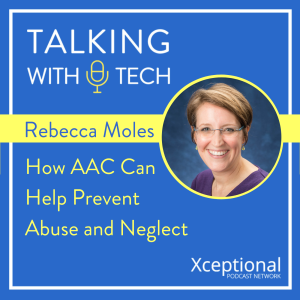
Tuesday Oct 16, 2018
Tuesday Oct 16, 2018
This week, the Talking with Tech team is joined by Dr. Rebecca Moles, a pediatrician who specializes in child abuse, to discuss how we can recognize and prevent the abuse and neglect of people with complex communication needs (CCN). Before the interview, Rachel, Lucas, and Chris connect to talk about some of their experiences with families dealing with abuse and how core vocabulary has been used in some cases to report neglect. The team concludes with a discussion of what we can do to prepare people with CCN to report abuse when it happens, including teaching the word “hurt”, teaching emotion words, and other strategies.
Next, Chris interviews Dr. Rebecca Moles about identifying abuse and neglect, particularly when working people with CCN. Areas covered include: why teaching language is so important to stopping abuse, signs that abuse may be occurring, and what happens (and doesn’t happen) when a report is made to Child Protective Services.
We want to know what you think! You can connect with us at our Facebook group Talking with Tech, on Twitter, and Instagram (@talkingwithtech)! Also, please subscribe and post a review for us on iTunes– it helps others to find us!
Links:
Crime Against Persons with Disabilities, 2009-2014 Statistics (bit.ly/abusestats2014)
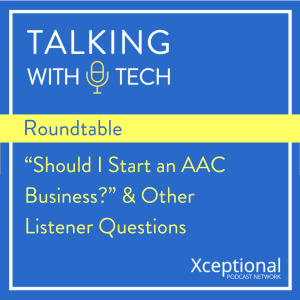
Tuesday Oct 09, 2018
Tuesday Oct 09, 2018
This week, the TWT team answers questions from our listeners! They address the following questions:
I’ve thought about starting an AAC consulting business, but I doubt at times that I have enough experience. What should I do?
What do you think about recent videos from Pyramid/PECS that seem to argue that we shouldn’t introduce core words until a student has already learned a number of fringe words?
How can we best talk to parents about interventions that are not evidence-based, like the rapid prompting method (RPM), when the parent has a positive opinion about it?
This is one of TWT’s most thought-provoking and interesting episodes. You won’t want to miss it!
We want to know what you think! Join us on Facebook at Talking with Tech and on Twitter and Instagram (@talkingwithtech). Also, please subscribe and post a review on iTunes - it helps others to find us!
Links:
PECS & Core Vocabulary 1: http://bit.ly/PECSCoreVocab1
PECS & Core Vocabulary 2: http://bit.ly/PECSCoreVocab2
ASHA Position Statement on RPM: http://bit.ly/ASHARPM
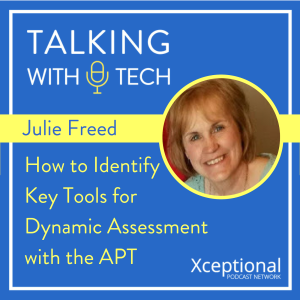
Tuesday Oct 02, 2018
Tuesday Oct 02, 2018
Talking with Tech is joined this week by Julie Freed, an SLP and school-based AAC specialist who helped create the AAC Planning Tool (APT)! Before the interview, Rachel and Chris discuss two communication assessments, the Continuum of Language Expression (COLE) and the Dynamic AAC Goals Grid (DAGG-2). Chris discusses his role in the creation of the COLE, what they considered when making it, and how it can be helpful when assessing emergent communicators. Rachel follows this with a discussion of the DAGG-2 and how it is similar to, and different from, the Communication Matrix. Rachel and Chris also chat about out how these assessments can be used as a baseline to determine the effectiveness of AAC implementation and measure student progress.
Next, Chris interviews Julie Freed, the Assistive Technology/AAC Resource Team Lead at Grant Wood Area Education Agency in Cedar Rapids, Iowa. Julie is the co-creator of the APT, a “menu” of AAC assessment tools that helps to guide the dynamic assessment process. It provides key tools to use as part of this process, including communication sampling forms and communication partner worksheets, that are suggested based on the student’s symbolic communication ability. Julie shares about why the APT was formed, the advantages she has seen from using it, and how it has helped to increase AAC competency and interest for many teachers and staff in her area!
We want to know what you think! Join us on Facebook at Talking with Tech and on Twitter and Instagram (@talkingwithtech). Also, please subscribe and post a review on iTunes - it helps others to find us!
Links:
Continuum of Language Expression (http://bit.ly/colegooglesheets & http://bit.ly/lcpscolepiktochart)
AAC Planning Tool (http://bit.ly/APTbinder)
Dynamic AAC Goals Grid (log into mytobiidynavox.com, then follow this path: Community >> Resources >> AAC Goal Writing)
"Golden Rules of AAC Competency In a New Era of Communication" Course by Lucas, Chris, & Rachel: (http://bit.ly/GoldenRulesofCompetency)
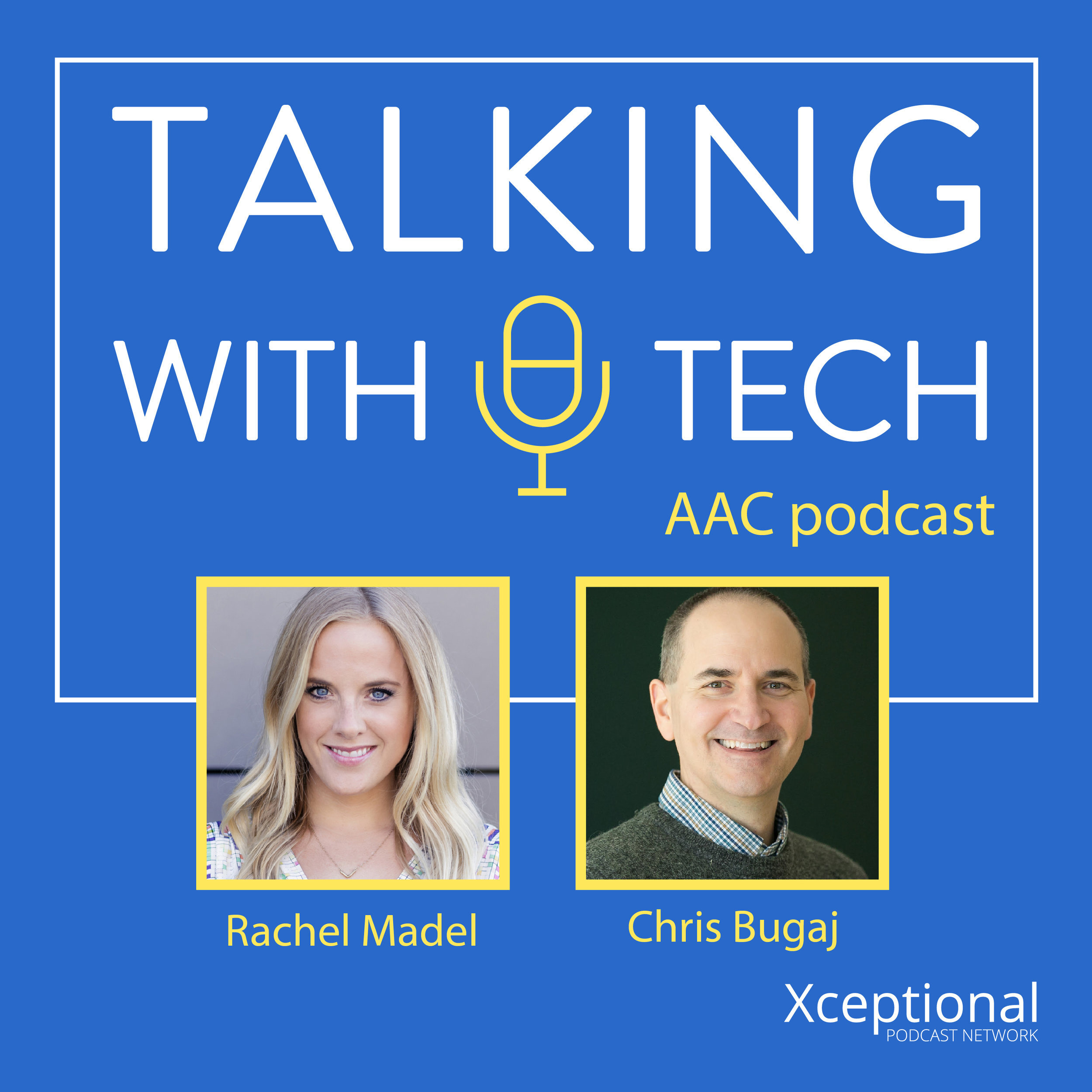
Join AAC experts Rachel Madel and Chris Bugaj as they dive into a weekly discussion about all things AAC (Augmentative and Alternative Communication). Every episode they deliver practical resources, clinical guidelines and relevant research to help clinicians better utilize technology for individuals with complex communication needs.
Episodes include interviews with industry thought-leaders, clinicians, parents, researchers and app developers to keep you on the pulse of the educational technology scene and better support communication through the use of technology.


